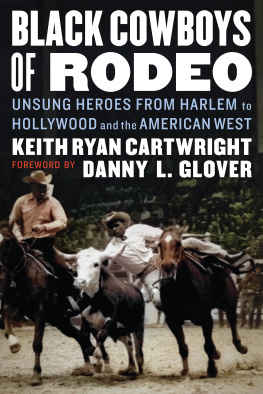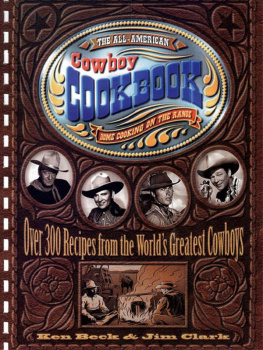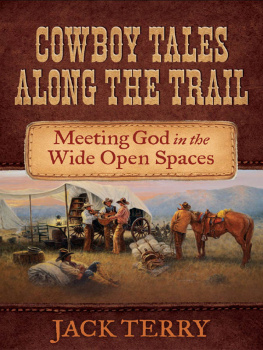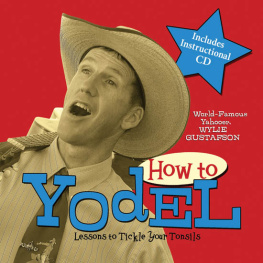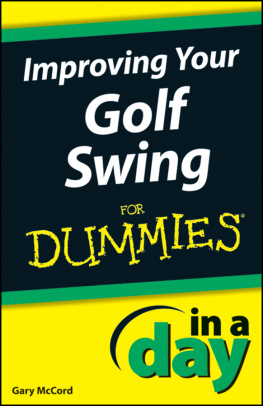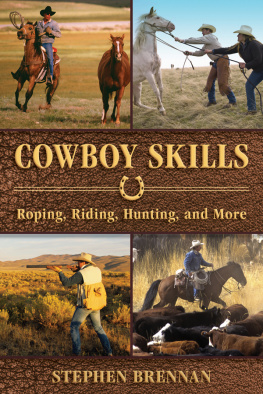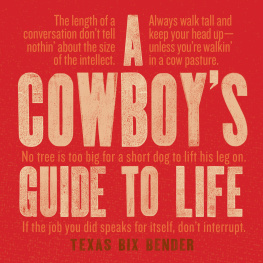
B is for Buckaroo
A Cowboy Alphabet
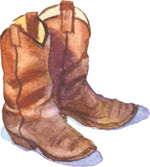
Written by Louise Doak Whitney & Gleaves Whitney
Illustrated by Susan Guy
Text Copyright 2003 Gleaves Whitney and Louise Doak Whitney
Illustration Copyright 2003 Susan Guy
All rights reserved. No part of this book may be reproduced in any manner without the express written consent of the publisher, except in the case of brief excerpts in critical reviews and articles. All inquiries should be addressed to:
Sleeping Bear Press
315 E. Eisenhower Parkway, Ste. 200
Ann Arbor, MI 48108
www.sleepingbearpress.com
2003 Sleeping Bear Press is an imprint of Gale.
Printed and bound in China.
10 9 8 7 6 5 4 3 (case)
10 9 8 7 6 5 4 3 2 1 (pbk)
Library of Congress Cataloging-in-Publication Data
Whitney, Gleaves.
B is for buckaroo : a cowboy alphabet / by Gleaves Whitney and Louise Doak
Whitney ; illustrated by Susan Guy.
p. cm.
Summary: The letters of the alphabet are represented by words, set in short
rhymes with additional information, relating to cowboys and ranch life.
pbk ISBN-13: 978-1-58536-336-0case ISBN-13: 978-1-58536-139-7
1. Cowboys-West (U.S.)Juvenile literature. 2. Ranch life-West (U.S.)
Juvenile literature. 3. West (U.S.)Social life and customs-Juvenile literature.
4. English language-Alphabet-Juvenile literature. [1. Cowboys-West (U.S.) 2.
Ranch life-West (U.S.) 3. West (U.S.)Social life and customs. 4. Alphabet.] I.
Whitney, Louise Doak. II. Guy, Susan, 1948- ill. III. Title.
F596 .W567 2003
978dc222003013207
For three boys who love the spirit of the West
Ian, Alasdair, and Andrew
GLEAVES & LOUISE

To my wonderful husband and family, thank you for all your love and support. I couldnt do it without you. Thank you also to Sleeping Bear Press. Its great working with you.
SUE
Note to the reader: Because the ranching tradition has roots in medieval Spain, many of the words we associate with cowboy ways come from Spanish. We have highlighted these words and hope you enjoy learning about them.
A
Andalusia is in southern Spain, where ranching and cowboy culture began hundreds of years before Columbus sailed to the Americas. Later in the fifteenth century when the Spanish came to the New World, they brought with them cattleancestors of the Texas longhornsand their knowledge of ranching. The Spaniards introduced cowboy ways in Mexico. Later when the Anglo-American pioneers went west, Mexican cowboys taught the early settlers how to take care of cattle from horseback. The Spanish influence can be seen in many cowboy words and customs to this day. Wrangler comes from a Spanish wordcaballerangothat means a man on a horse.
The American cowboy was first seen in Texas in the 1850s. American settlers learned from their Mexican neighbors how to take care of the longhorn cattle that roamed wild and free.
When the Civil War ended slavery in the United States, many newly freed African-Americans began their life of freedom working as cowboys.
Andalusia begins with an A Spanish land thats far away. Its where our story begins of the colorful cowboy way.
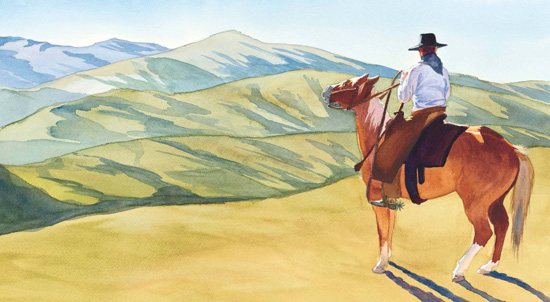
B
The word buckaroo comes from the Spanish name for cowboy, which is vaquero. If you say vaquero and buckaroo, you will hear that they sound similar.
A cowboy is someone who tends cattle, usually from horseback. Cowboys do many jobs including watching over cattle as they graze on the prairie, rounding them up to bring them into the corral, taking care of them when they are sick, branding them to identify ownership, and working with the horses that are the cowboys partners.
B is also for bronc or bronco, Spanish for a wild, unbroken horsea mustang that is not ready for riding. Broncos were descended from the Arabian horses that Spanish explorers brought with them to the New World. Found running wild on the plains, these horses had to be broken by cowboys who would train them to be good working partners. A highly skilled cowboy that can break a horse is called a broncobuster.
B is for the Buckaroo, whos a cowboy through and through. These broncobusters youll often see riding on horseback, yelling Whoopee!
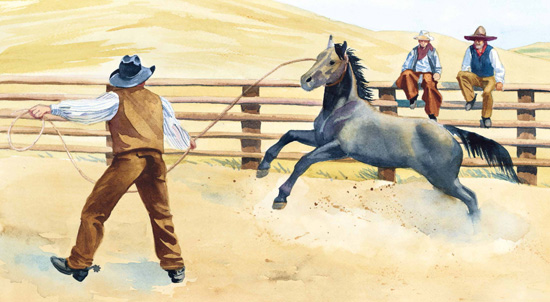
C
The chuck wagon was named after its founder, Charles (Chuck) Goodnight, a Texas cattle rancher. Goodnight knew that cowboys on long trail rides like to eat tasty vittles (food). The chuck wagon was where the cook, often-called Cookie, prepared meals. Dinners included stews, baked beans, and biscuits. The cowboys treated Cookie with great respect, for they knew that if Cookie got upset, he might accidentally burn the beans or biscuits!
Jerky is a popular trail snack for cowboys. It is thin strips of meat that are dried and salted. Because jerky keeps almost forever and is light to carry, cowboys like to keep it in their packs to nibble on.
Chuck wagon starts with the letter C . Its the place where cowboys like to be, to enjoy tasty vittles and a cup of coffee, and tell tall tales out on the prairie.
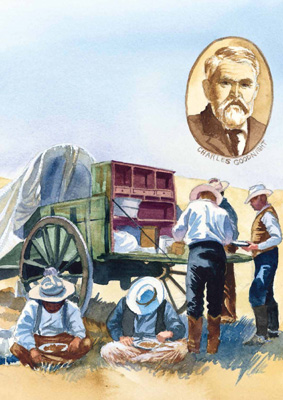
D
When cowboys are roping cattle, they often need to dally, or wrap their rope around the saddle horn. The dally helps the cowboy control a cow on the other end of the rope. The Spanish vaqueros, who used the term dale vuelta to describe wrapping their rope around the saddle horn, invented dallying.
Drover is another name for cowboy, because a cowboy drove cattle on the trail drive. Dogie, not to be confused with a little dog or doggie, is another word for calf.
Cowboy work is dangerous. One of the biggest dangers a cowboy could face is a stampede, the wild, chaotic running of cattle on a trail drive. It is hard to predict what might cause a stampede, but lightning, tumbleweeds, a coyote call, or rattlesnake might spook the cattle and cause them to run wild. It was what all cowboys feared the most because it was dangerous and difficult to get the cattle under control. Cowboys would race on their horses to head the cattle off and get them to turn direction. With care the herd could then be circled around and slowed down.
D is for the Dally the drovers like to make, when they need a little dogie to put on the brake!
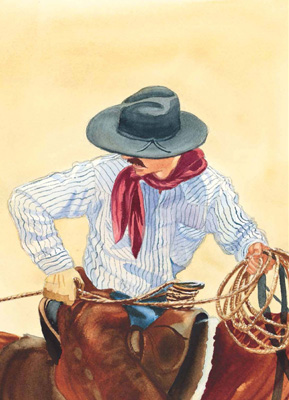
E
Endless plains refer to the Great Plains, where most cowboys worked in the old days and continue to work today. These great grasslands were crisscrossed by most of the cattle drives from the 1860s to the 1880s.
The Great Plains extend all the way from Canada south to Texas and include the Canadian provinces of Alberta, Saskatchewan, and British Columbia, plus the Northwest Territories, and the states of Montana, North and South Dakota, Wyoming, Nebraska, Colorado, Kansas, New Mexico, Oklahoma, and Texas.
Next page


